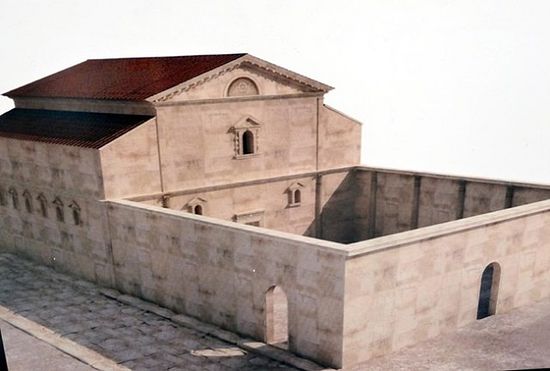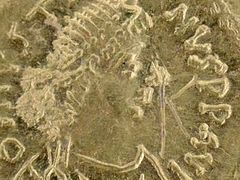Source: Archaeology in Bulgaria
March 24, 2016
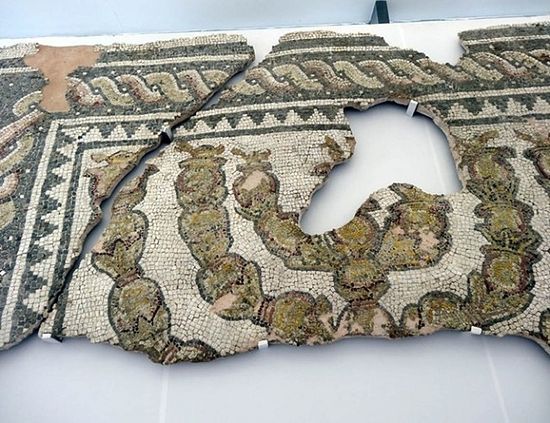 The restored 3rd century AD floor mosaics from the Antiquity Synagogue in ancient Philipopolis, Bulgaria’s Plovdiv, depict a large menorah. Photo: 24 Chasa daily
The restored 3rd century AD floor mosaics from the Antiquity Synagogue in ancient Philipopolis, Bulgaria’s Plovdiv, depict a large menorah. Photo: 24 Chasa daily
Absolutely unique 3rd century AD floor mosaics from the Antiquity Synagogue in the southern city of Plovdiv, Bulgaria’s only Jewish temple from the Antiquity period, have been restored by the Plovdiv Museum of Archaeology.
The mosaics, which are made with red, orange, green, black, and white stones, have never been shown to the public before, and this is the first time they can be seen in a form that is as close to their original as possible.
The Antiquity Synagogue of ancient Philipopolis (Trimontium in the Roman period), as Plovdiv was known in ancient times, was built in the first half of the 3rd century AD, possibly during the Severan Dynasty (r. 193-235 AD).
It is said to be the earliest known and the largest Antiquity synagogue on the Balkan Peninsula.
Its ruins were first discovered during rescue excavations in 1981 but its mosaics have been fully restored and showcased just now, 35 years later.
The Jewish temple was damaged several times in barbarian invasions and anti-Semitic persecution, and was rebuilt after each one of those, until the end of the 6thcentury AD when it was abandoned for good.
The Antiquity Synagogue was located close to the Small Basilica of ancient Philipopolis; its existence, and the inscriptions in Greek and Latin found in its ruins are taken to mean that in ancient times today’s Plovdiv was a truly cosmopolitan city.
The exhibition of the 3rd century mosaics from the ancient Jewish temple by the Plovdiv Museum of Archaeology is also the first time the mosaics have been seen in their true scale, reports the 24 Chasa daily.
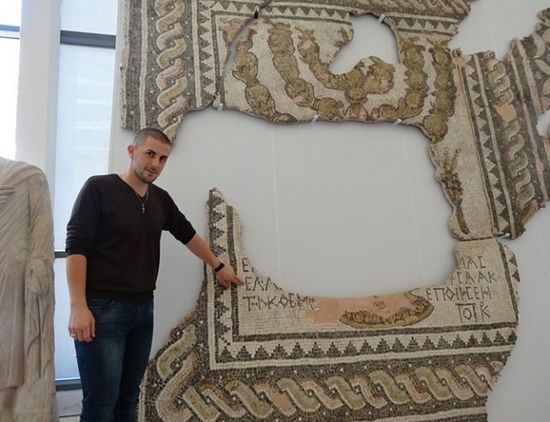 A specialist from the Plovdiv Museum of Archaeology shows the newly restored and newly exhibited floor mosaics from the Antiquity Synagogue of ancient Philipopolis (Trimontium). Photo: 24 Chasa daily
A specialist from the Plovdiv Museum of Archaeology shows the newly restored and newly exhibited floor mosaics from the Antiquity Synagogue of ancient Philipopolis (Trimontium). Photo: 24 Chasa daily
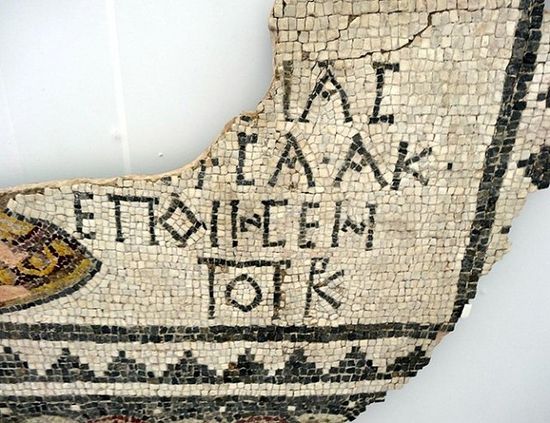 Part of one of the inscriptions found on the floor mosaics in the Antiquity Synagogue in Plovdiv. Photo: 24 Chasa daily
Part of one of the inscriptions found on the floor mosaics in the Antiquity Synagogue in Plovdiv. Photo: 24 Chasa daily
The central image of the mosaics is a large menorah (a seven-lamp lamp stand, the symbol of Judaism). Unfortunately, the lower part of the candelabrum could not be restored because the mosaics were destroyed in the Early Byzantine period.
To the right of the menorah, there is a depiction of a lulav (a date palm tree branch), and in the bottom corners there are inscriptions in Ancient Greek.
The inscription mentions with certainty the Jewish origin of the temple’s donors – Isaac and Joseph, who are said to be representatives of a sizable Jewish community in the ancient city.
The Synagogue, which is a basilica-type building, also had a second layer of mosaics added after a reconstruction in the 5th century AD; the artists of this second layer appears to have shied away from Jewish symbols.
“[The Antiquity Synagogue] is a unique monument of immense historical and artistic value," states lead archaeologist Elena Kisyakova who discovered the ruins and mosaics of the ancient Jewish temple during rescue excavations.
She adds that the Synagogue testifies to the important role that the Jews played in the public life of ancient Philipopolis (Trimontium), today’s Bulgarian city of Plovdiv.
The existence of the temple is also construed as evidence of the arrival of settlers from the eastern provinces of the Roman Empire, who are believed to have been rich merchants and craftsmen.
Background Infonotes:
The Antiquity Synagogue in the southern Bulgarian city of Plovdiv (ancient Philipopolis, also called Trimontium in the Roman period) is the only known synagogue in Bulgaria from the Antiquity period. It was in operation in the 3rd-4th century AD.
It is said to be the earliest known and the largest Antiquity synagogue on the Balkan Peninsula.
Its ruins were first discovered by archaeologist Elena Kisyakova during rescue excavations in 1981 but its mosaics were fully restored and showcased by the Plovdiv Museum of Archaeology only in 2016, 35 years later.
They were found near the Small Basilica in Plovdiv; only its foundations and part of its floors have been preserved. It was a three-room basilica with a large yard. The archaeological excavations have found two layers of decorative floor mosaics depicting geometric motifs, a large menorah (a seven-lamp lampstand, the symbol of Judaism) (the lower part of the candelabrum mosaics was destroyed), a lulav (a date palm tree branch), and inscriptions in Greek and Latin.
A four-line inscription in Greek names the donors of the synagogue, Isaac and Joseph, and says they were representatives of the large Jewish community in the ancient city. The existence of the Jewish temple and its inscriptions are seen as evidence of the cosmopolitanism of ancient Philipopolis (Trimontium), today’s Plovdiv.
The Antiquity Synagogue in Bulgaria’s Plovdiv was probably built during the time of the Severan Dynasty of the Roman Empire (193-235 AD). It was badly damaged after the Goths conquered the city ca. 250 AD; subsequently, it was rebuilt, and then destroyed again during the persecution of the Jews by Byzantine (Eastern Roman) Emperor Arcadius (r. 395-408 AD).
Later the Antiquity Synagogue was reconstructed and expanded, with a second layer of floor mosaics added. This second layer has been found to have been rougher, without depictions of specifically Jewish symbols.
The Antiquity Synagogue in Bulgaria’s Plovdiv was ultimately destroyed at the end of the 6th century AD.
***
The Small Basilica of ancient Philipopolis, which is located in the downtown of today’s southern Bulgarian city of Plovdiv, was built in the 5th century in honor of then military commander of the province of Thrace, Flavius Basiliscus.
Basiliscus became Emperor of the Eastern Roman Empire, i.e. Byzantium (r. 475-476 AD) but was deposed by his predecessor, Byzantine Emperor Zeno (r. 474-475 and 476-491 AD) who ordered the destruction of any traces left by Basiliscus. This led to the deletion of several lines from a donation inscription in the Small Basilica in Philipopolis.
The basilica itself is a three-nave Early Christian church with a length of 20 meters, including the apse, and a width of 13 meters. It is located on the eastern outskirts of the ancient city of Philipopolis close to the inside of the eastern section of the fortress wall near a fortress tower dating back to the 2nd-4th century. It was discovered by accident in 1988 during construction works for a residential building, and has been granted the status of a national culture monument.
It was restored between 2010 and 2014 under a project of the Bulgarian Culture Ministry, Plovdiv Municipality, and the America for Bulgaria Foundation, which provided a USD 1 million grant for its excavation and restoration.
***
The history of the southern Bulgarian city of Plovdiv – often dubbed the oldest city in Europe – began with the human settlement on the ancient hill of Nebet Tepe (“tepe" is the Turkish word for “hill"), one of the seven historic hills where Plovdiv was founded and developed in prehistoric and ancient times.
The hills, or “tepeta", are still known today by their Turkish names from the Ottoman period. Out of all of them, Nebet Tepe has the earliest traces of civilized life dating back to the 6th millennium BC, which makes Plovdiv 8,000 years old, and allegedly the oldest city in Europe. Around 1200 BC, the prehistoric settlement on Nebet Tepe was transformed into the Ancient Thracian city of Eumolpia, also known as Pulpudeva, inhabited by the powerful Ancient Thracian tribe Bessi.
During the Early Antiquity period Eumolpia / Pulpudeva grew to encompass the two nearby hills (Dzhambaz Tepe and Taxim Tepe known together with Nebet Tepe as “The Three Hills") as well, with the oldest settlement on Nebet Tepe becoming the citadel of the city acropolis.
In 342 BC, the Thracian city of Eumolpia / Pulpudeva was conquered by King Philip II of Macedon renaming the city to Philippopolis. Philippopolis developed further as a major urban center during the Hellenistic period after the collapse of Alexander the Great’s Empire.
In the 1st century AD, more precisely in 46 AD, Ancient Thrace was annexed by the Roman Empire making Philippopolis the major city in the Ancient Roman province of Thrace. This is the period when the city expanded further into the plain around The Three Hills which is why it was also known as Trimontium (“the three hills").
Because of the large scale public construction works during the period of Ancient Rome’s Flavian Dynasty (69-96 AD, including Emperor Vespasian (r. 69-79 AD), Emperor Titus (r. 79-81 AD), Emperor Domitian (r. 81-96 AD)), Plovdiv was also known as Flavia Philippopolis.
Later emerging as a major Early Byzantine city, Plovdiv was conquered for the First Bulgarian Empire (632/680 – 1018 AD) by Khan (or Kanas) Krum (r. 803-814 AD) in 812 AD but was permanently incorporated into Bulgaria under Khan (or Kanas) Malamir (r. 831-836 AD) in 834 AD.
In Old Bulgarian (also known today as Church Slavonic), the city’s name was recorded as Papaldin, Paldin, and Pladin, and later Plavdiv from which today’s name Plovdiv originated. The Nebet Tepe fortress continued to be an important part of the city’s fortifications until the 14th century when the Second Bulgarian Empire (1185-1396 AD) was conquered by the Ottoman Turks. During the period the Ottoman yoke (1396-1878/1912) when Bulgaria was part of the Ottoman Empire, Plovdiv was called Filibe in Turkish.
Today the prehistoric, ancient, and medieval settlement on Nebet Tepe has been recognized as the Nebet Tepe Archaeological Preserve. Some of the unique archaeological finds from Nebet Tepe include an ancient secret tunnel which, according to legends, was used by Apostle Paul (even though it has been dated to the reign of Byzantine Emperor Justinian I the Great (r. 527-565 AD)) and large scale water storage reservoirs used during sieges, one of them with an impressive volume of 300,000 liters. Still preserved today are parts of the western fortress wall with a rectangular tower from the Antiquity period.

